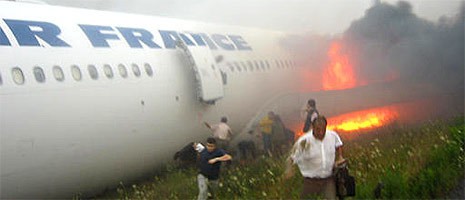I figure that I’ve earned the right to occasionally re-post a past favorite article when circumstances so dictate (hey, it’s my site!). I’m doing that today. I wrote this one a couple of years ago and was thinking about it yesterday while sitting on a plane in the pouring rain.
At four o’clock in the afternoon of August 2, 2005, I was just a few minutes into a long online training session with a software manufacturer. As we spoke, and as the technician showed me the features of this software, I suddenly noticed that it had gotten very dark in my office. I looked outside and saw that the sky was as dark as ever I’ve seen an afternoon summer sky. Within minutes rain began to fall—hard, driving rain—the kind of rain that will soak you to the skin in seconds. I said to the technician, “this is the worst rain storm I’ve ever seen.” The rain was falling so hard and in such great drops that I could only barely see the house across from my own.
The pilots of Air France flight 358 may have been echoing my words. As the rain fell in Oakville, it also poured down in nearby Toronto. At that very moment their aircraft was on its final approach to Toronto’s Pearson International Airport. The airplane, an Airbus A340, had left France’s Charles de Gaulle International Airport just over eight hours prior to this and the passengers—businesspersons, vacationers, and students—had enjoyed an uneventful flight. Uneventful so far, that is.
As they neared Toronto, the pilots were warned of thunderstorms in the area and, as they began their approach, were told that jets landing moments earlier had warned of poor braking action on the runways below. Their weather radar showed heavy rain immediately over the airport. Despite such warnings, the pilots felt they would be able to safely land their aircraft. When they were nearly 200 feet above the runway threshold, while on the instrument landing system approach to Runway 24L and as the pilots reacted to rising winds, the aircraft began to deviate slightly from its glidescope. A series of lightning strikes struck the ground in the area of the runway. Flight 358 crossed the runway threshold nearly 40 feet above the standard glideslope. As it neared the ground, violent winds rocked the plane and heavy rain pelted it, drastically reducing forward visibility.
The pilots, unaware that they still had plenty of time to bring the plane around for a second, safer landing attempt, pressed forward. The aircraft’s wheels touched down at 4:01 PM, but did so at almost the halfway point of the 9,000 foot runway. Improper procedures kept the pilots from activating the thrust reversers until 13 seconds after touchdown and from going to full reverse for a further 3.5 seconds. In such weather conditions and with delayed activation of thrust reverses, the laws of physics dictated that a plane weighing almost 185 tons would require nearly 6,700 feet of usable runway to come to a complete and safe stop. The pilots did not yet know it, but they were facing an impossible task.
With the pavement covered in water and a runway surface that was now far too short, the pilots did their best to stop the aircraft as it skidded down the runway. Twenty six seconds after touching down, still traveling at 90 mph as it came to the end of the runway, the Airbus careened across a strip of grass, crossed a service road, crushed fences and light posts, and hurtled across Convair Drive before coming to rest, finally, in a small ravine adjacent to Etobicoke Creek. Some fifteen to twenty seconds had elapsed from the time the aircraft left the runway. Amazingly, the fuselage was largely intact. But as the plane had crossed Convair Drive, fuel had begun to leak and had immediately caught fire. As the plane came to a halt the fire began to spread and to intensify.
It had been almost three decades since the last serious incident at Pearson Airport. On June 26, 1978, Air Canada flight 189 to Winnipeg suffered a burst tire while taking off. The pilot aborted the takeoff but did so too late. That plane, a DC-9, also overran the runway and plunged into Etobicoke Creek, killing two passengers and injuring most of the 105 who survived. It was an eerie foreshadowing of the events of August 2, 2005.
Since flight 189 in 1978 there had been no serious occurrences at the airport—no major accidents or incidents. For twenty-seven years the firefighters had trained to deal with a situation like this one. An entire generation of firefighters had come and gone without seeing a single incident. They could almost be excused for being under-prepared, slow to respond, slow to act.
Seeing flashes of fire and realizing the plane had overrun the runway, a tower controller activated the airport’s crash alarm twenty-six seconds after flight 358 left the runway. But by this time the airport firefighters who, due to the bad weather, had been in the alarm room and had watched the plane land, were already on their way to the crash scene. They arrived only 52 seconds after the plane left the runway. Already they found that half of the passengers had been evacuated. The Air France flight attendants had reacted promptly and just as their training dictated, ushering the passengers to the closest available exists. By the time fire began to consume the fuselage, the last passenger had been evacuated.
Despite twenty seven years without an incident, those firefighters were ready and they responded well in advance of the parameters dictated by safety regulations. In less than a minute they were on the scene and were assisting the passengers. It took less time for them to get to the crash site than it did for fully half of the passengers to leave it.

In the aftermath of this crash, and as I read reports about it, I immediately zeroed in on this simple number that appeared almost unbelievable to me: 52 seconds. I couldn’t believe just how ready these firefighters were.
The theme of preparation is important in the Bible and was much on my mind around the time of that crash as it was then that I was in the early stages of writing a book on the subject of discernment. This incident has been sitting in the back of my mind ever since. Preparation, I’m convinced, is one of the keys to discernment. In all my studies on discernment, this was the one thing that stood out above everything else. The simple fact is that those who are discerning are those who prepare themselves by knowing and studying Scripture. They dedicate themselves to the simple disciplines of reading, prayer and sitting under biblical preaching at the local church.
Just this morning I spent some time studying Genesis 3 and I read of Satan tempting Eve. It seems that Eve was somehow inadequately prepared to deal with this adversary. She was so easily led astray, so easily allowing Satan to lead her away from what was true. Perhaps she just hadn’t given enough thought to the command of the Lord that she not eat of the tree of the Knowledge of Good and Evil. Perhaps she had never paused to consider what God meant by not eating. Regardless, she certainly did not trust in His Word or in His goodness. She was unprepared. And so often we are the same way. Though Satan’s tactics have changed little in the millennia between then and now, we are still woefully unprepared to deal with him.
The crash of Flight 358 ended far better than it could have. Almost unbelievably, all of the 297 passengers and 12 crew members survived the crash. There were only a few serious injuries, almost all of which were caused by the leap from the plane to the ground below. Air France flight 358 was a disaster averted.
The last to leave the shattered wreckage were the plane’s First Officer and several airport firefighters. They firefighters had swept through the plane ensuring that no one had been left behind. They stepped out just as the fire consumed and destroyed what was left of the cabin. They were where they were needed when they were needed. They were ready.










